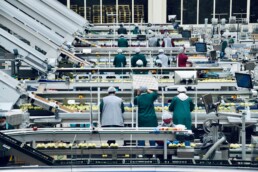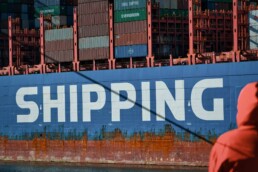Supply Chain Rebound Data Reveals Encouraging Signs
The ongoing debate surrounding the U.S. economy’s state—recession, impending recession, or recovery—has persisted over the past year.
The aftermath of the post-COVID resurgence has introduced unprecedented fluctuations in economic indicators, posing challenges for accurate assessments. Supply chain rebound data suggests we may soon see a recovery.

Supply Chain Rebound Data Suggests A Recovery May Be Coming
Despite continued growth in retail sales, June recorded a modest 0.3% rise from May and a year-over-year increase of 1.5%. However, this growth remains the slowest since May 2020, according to the Commerce Department. Meanwhile, the Institute for Supply Management (ISM) reported a positive trend in the services economy, with the Services PMI marking a 3.6% increase to reach 53.9, indicating growth. Conversely, manufacturing experienced a slight decline in June, with the ISM reporting a reading of 46, down 0.9% month-on-month.
Promising data from the flexible work platform Instawork suggests that the supply chain could be on the brink of a significant rebound. The manufacturing sector is witnessing rising pay rates and an upsurge in labor demand. As businesses gradually reduce inventories from their COVID-induced highs, some are resuming their operations. The U.S. Census Bureau reported a 0.2% improvement in total business inventories to sales ratios in May compared to April. Although this ratio is higher, it remains 1.8% lower than May 2022.

Instawork’s Chief Economist, Daniel Altman, compiled data indicating that excessive inventories led to reduced work hours as manufacturers curtailed production. However, this trend is shifting, particularly among west coast manufacturers.
Notably, transportation, warehousing, wholesale, and retail trade have exhibited growth since March, reflecting increased demand for flexible labor. Hourly wages in manufacturing are also experiencing an upward trajectory, with May’s figures nearing $18 per hour, up from below $17 in April. In contrast, pay rates in transportation, warehousing, wholesale, and retail trade have remained relatively stable month-over-month.
Altman observes that the post-2022 economic reopening prompted a shift towards spending on services and experiences, causing a stall in goods demand. However, this surge has subsided, excess inventories have diminished, and demand for goods is resurging.

Economically, the second half of the year appears poised for normalization, closer to pre-pandemic times, according to Altman.
Instawork’s data highlights a significant surge in manufacturing labor demand, especially in the western region, with Phoenix leading the way. Manufacturing shifts in Phoenix quadrupled from January to May, while the Bay Area saw a 50% increase, positioning it as a mature market.
In the Midwest, labor demand aligns with the national trend, showing a slight recovery after a seasonal dip. Chicago, in particular, could benefit from the tight labor supply in the region. However, the East, including Atlanta and Philadelphia, does not show immediate signs of manufacturing recovery. The company suggests that a potential manufacturing rebound could be spearheaded by tech-focused businesses, moving from west to east, culminating in a more balanced trend by year-end, closer to pre-pandemic norms.
Altman clarifies that the decline in hours worked isn’t necessarily indicative of lower productivity; instead, it may reflect an increased availability of workers. Instawork’s platform currently boasts nearly 5 million available workers, up from 3 million a year ago. Although unemployment has remained relatively stable, Altman attributes the increase to more individuals seeking flexible work arrangements or supplementary employment.
Need more information about supply chain health?
Let’s Talk!
Yellow Trucking Firm Bankruptcy: Impact on Logistics and Workers
Navigating Turbulence: Yellow Trucking Firm’s Bankruptcy and Its Ripple Effects on U.S. Logistics and Workers
Yellow Corp, formerly known as YRC Worldwide, has faced a dire financial crisis, leading to the cessation of its operations. The Yellow trucking firm bankruptcy stemmed from their inability to restructure and refinance its substantial debt, exceeding a billion dollars, forced it to insolvency. This move came after failed attempts to manage its financial turmoil, despite receiving bailout funding from the federal government and making worker concessions.

Teamsters Union’s Perspective
Sean M O’Brien, the General President of the Teamsters Union, highlighted Yellow’s historical mismanagement despite significant financial support. The inability to navigate these challenges underscores the extent of the crisis that led to the Yellow trucking firm bankruptcy.
Operational Challenges and Industry Consequences
As the third-largest trucking company in the U.S. specializing in less-than-truckload shipments, Yellow had a pivotal role in transporting goods for major retailers like Walmart and Home Depot, as well as manufacturers and Uber Freight. Concerns emerged over potential losses or disruptions in cargo shipments to Yellow, prompting some customers to halt business dealings.
Role of Teamsters Union and Debt Restructuring
Yellow’s attempt at restructuring and modernization, termed “One Yellow,” was thwarted by the Teamsters, according to the company’s claims. These efforts were crucial for Yellow’s survival and its ability to refinance a substantial debt of approximately $1.3 billion by 2024. Notably, this debt included a $700 million pandemic relief loan from the U.S. government, which granted stake in the company.
Impact on Workers and Closure of Operations
Notices sent to customers and employees confirmed the shutdown of Yellow’s operations, as reported by The Wall Street Journal. The company’s non-union workers faced significant layoffs, further highlighting the severity of the crisis. Additionally, the closure of YRC Freight Canada, a Yellow subsidiary, resulted in the suspension of work for 128 union members.
Yellow’s bankruptcy has sent shockwaves through the U.S. trucking industry, prompting discussions about financial management, debt restructuring, and the broader impact on supply chains. The company’s struggles serve as a reminder of the challenges faced by businesses in maintaining financial stability, especially in a demanding economic environment.
Have questions about how this affects fulfillment and supply chain?
We Can Help!
Navigating China's Economic Slowdown Risks
Managing Supply Chain Risks During China’s Economic Slowdown
Strategically Addressing Supply Chain Risks
The global economic landscape has seen significant shifts, with China’s economic growth rate declining from double digits to 3% in 2022. Navigating supply chain risks amid China’s economic slowdown is not an easy task. The repercussions of factory and city closures during the pandemic have affected China’s ability to recover fully. As a result, many U.S. companies are reconsidering their sourcing and manufacturing strategies in the region. Some are opting to move their production to other low-cost countries like Vietnam, India, and Mexico, while others are even reshoring manufacturing back to the United States. This shift has put Chinese suppliers in a challenging position, with declining business leading to potential factory closures or bankruptcies.

The Impact of Chinese Supplier Bankruptcy
When a Chinese supplier goes bankrupt, it can have severe consequences for the businesses relying on them. Overall, production may come to an abrupt halt, leaving companies with little recourse to recover their investments. Down payments made for production, the supply of raw materials, and time spent teaching the supplier manufacturing processes may be lost with little hope of recovery. Chinese bankruptcy often involves sudden factory shutdowns, leaving business owners to vanish to other locations.

Deciding to Stay or Leave China
Amid this economic uncertainty, companies must weigh their options and decide whether to continue operations in China or seek alternatives elsewhere. For some, China remains a significant growth market, and manufacturing for local consumers remains a viable strategy. Others may have to stay due to exclusive supplier relationships or specific manufacturing capabilities unique to China. Regardless of the decision, supply chain managers must remain vigilant for signs of supplier financial distress.

Watch For Warning Signs
There are certain warning signs that supply chain managers should keep an eye on. Particularly, if a Chinese supplier starts requesting larger than usual down payments or continues to ask for additional funds to purchase raw materials, it could indicate financial difficulties. Delays in production may also be a red flag, as the supplier may divert funds from down payments to keep their operations running, leaving your order in jeopardy. Reaching out to other companies serviced by your vendor can also provide valuable insights into the supplier’s current situation.

Verifying Supply Chain Stability
Regular site visits to suppliers’ factories are crucial in maintaining transparency and verifying that production is proceeding as expected. By physically inspecting raw materials and confirming that your products are in progress, you can gain assurance about the supplier’s stability. Moreover, it’s essential to have contingency plans in place and establish alternate sources should the Chinese supplier declare bankruptcy.

Mitigating Supply Chain Risks During A Slowdown
In today’s dynamic global supply chain, proactive risk management is essential. By closely monitoring and understanding your supply chains, you can identify potential risks early on and take necessary actions. Chiefly, conducting site visits, building relationships with alternate suppliers, and creating contingency plans can help mitigate the impacts of supplier bankruptcy and other unforeseen disruptions.
At Falcon, we understand the complexities of managing supply risks amid economic slowdowns. With our expertise in 3PL/fulfillment services, we can help you navigate solutions to safeguard your supply chain operations. Our proactive approach helps you keep your business agile and resilient in the face of global economic challenges.
Want to see what Falcon Fulfillment can do for you?
Let’s Talk!


